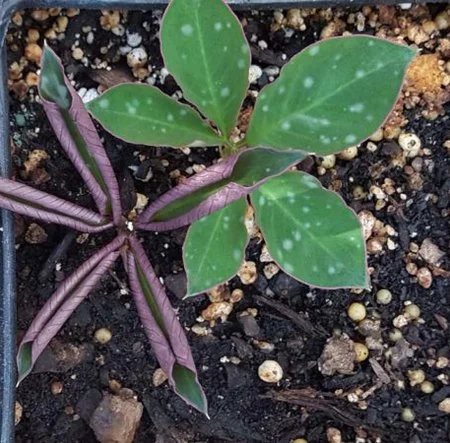AMORPHOPHALLUS ALLENII
ORIGINAL DESCRIPTION:
Amorphophallus allenii A. Galloway, Malkm.-Huss., Prehsler & Claudel sp. nov.
Type: from a plant cultivated by A. Galloway (orig. coll.: THAILAND, Kanchanaburi Province), 18 June 2018, Galloway AGA-2672–01-T (holotype, QBG, spirit collection).
Photo by Allan Galloway
SYNONYMS: N/A
DISTRIBUTION: Thailand | Amorphophallus allenii was first seen as a cultivated pot plant at a nursery in Bangkok but without any locality data being available. Later it has been found in situ (Sira Niwesrat, pers. comm.) and at present it is only known from the type locality, where it grows in cracks of limestone rock boulders in dappled shade.
CLIMATE: Unknown
ECOLOGY: Open forests, arid thickets; 800-1000 m
SPECIES DESCRIPTION:
Tuber narrowly elongate, 1–1.5 cm in diam., 30–40 cm long, brown, with no offset development. Leaf solitary; petiole to 12 cm long and 0.75 cm in diam., smooth, dark olive-green to pale brown, sometimes with few creamy-white vertical lines 0.2–2 cm long; lamina to 40 cm wide, rachises short, narrowly winged distal from basal branchings; leaflets few, elliptic, to 16 cm long, 8 cm in diam., upper side dark green with or without irregularly shaped, diffuse silvery-white to pale silvery-green spots, margins magenta, lower side pale green to pale reddish-green.
INFLORESCENCE:
Inflorescence solitary; peduncle as petiole, 11–13 cm long, 0.75 cm in diam.; spathe cymbiform, ovate, 8–9 cm long, 3.5 cm wide, base and limb demarcated by a slight constriction, outside lower and upper parts greenish white, inside lower part burgundy, with irregular conical warts; upper part greenishwhite. Spadix longer than spathe, to 15 cm long; female zone cylindric, 1 cm long, 0.5 cm in diam. (incl. styles), flowers congested; sterile zone absent between female and male zone; male zone cylindric, 4 cm long, 0.5 cm in diam., flowers congested, without staminodes; appendix elongate-conical, bent forward, top obtuse, smooth to shallowly rugose, to 10 cm long, 0.6 cm in diam., greenish-white. Ovaries depressed, ca. 1 mm high, ca. 2 mm in diam., pale green, unilocular; style ca. 1 mm long, ca. 1 mm in diam., pale green to rosy; stigma flattened, ca. 0.75 mm high, ca. 2 mm in diam., shallowly 2–3 lobed, surface papillate creamy-white. Male flowers the lowest stamens enlarged and partly fused (synandria); stamens short, ca. 0.75 mm long, 2–2.3 mm in diam., creamy-white; filaments almost absent, ca. 0.2 mm long; anthers ca. 0.5 mm long, creamy-white.
VARIEGATED FORMS: N/A
ETYMOLOGY: The species is named in honor of Craig Allen, Conservatory Manager at Fairchild Tropical Botanical Garden and Amorphophallus horticulturist, Miami, Florida, USA
NOTES: Amorphophallus allenii is a member of the Amorphophallus pygmaeus-alliance (Hetterscheid, 2006) together with Amorphophallus josefbogneri Hett., Amorphophallus lunatus Hett. & Sizemore, Amorphophallus operculatus Hett. & Sizemore, Amorphophallus pygmaeus Hett. and Amorphophallus sizemoreae Hett., which are all endemic to Thailand. Species are mostly rather small, usually less than 60 cm in height and have dark to very dark green leaves with a thin rose to pink margin and often a reddish to rosy green colored underside. Spathes are whitish, concave with incurved margins and may show a slight constriction between the basal part and the limb. Anthers of the lowest male flowers show a tendency to fuse into a more or less pronounced synandria. Morphologically Amorphophallus allenii is closest to Amorphophallus josefbogneri with which it shares an elongate tuber and a similar leaf architecture and texture. It differs from the latter by a longer tuber, a broader leaf, larger leaflets, usually conspicuously pronounced silvery white to very faint silvery green spots on the leaflets (always absent in Amorphophallus josefbogneri), a longer spadix of up to 15 cm (up to 11 cm in Amorphophallus josefbogneri) and congested pistillate flowers (distant in Amorphophallus josefbogneri).
CULTIVARS: N/A
HYBRIDS: N/A

















